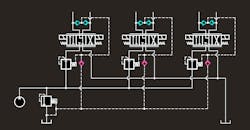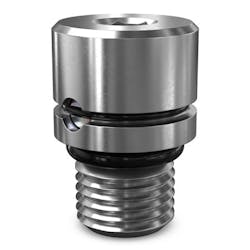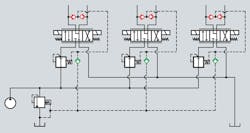Compact Design Solves Check-Valve Challenges
Check valves are among the simplest and most widely used valves in fluid power. They allow fluid to flow in one direction but not the other. They are used for control functions and zero-leak versions are widely used for load holding because of their simplicity and reliability. Adding to their versatility is that they come in conventional line mounted and cartridge versions.
Typical thread-in cartridge style check valves are large and mount to the surface of a manifold block. This surface mounting adds complexity and cost from the additional machining or drilling of internal passages required to integrate the valve into the circuit.
Isolation Check Valves
When used as a pressure-sensing isolation check valve, the need for zero leakage and flow rates greater than 4 lpm (1 gpm) are not needed. Standard check valves are available in a C8-2 or C10-2 cavity configurations, but these are large and costly, given the number that would be needed. Geometry of the cavity required can also restrict their placement within a manifold. The schematic shows an example circuit where isolation checks are used.
As with cast iron sectional valves, a common practice to reduce cost and save space was to drill the check valve seat into the manifold, then drop in a ball, spring, and port plug. Although simple in design and function, these types of check valves are not durable, as neither aluminum nor cast iron can hold up to the pressure cycles and flow impacting the ball onto the seat. Further complications arise for service due to the difficulty of changing out loose springs and balls in the field. If the check ball seat does become damaged, replacing the manifold is usually more economical than repairing it.
However, the compact design of a new thread-in cartridge valve from Parker Hannifin overcomes this limitation by allowing internal mounting. The CVH021 check valve lends itself to use in circuits for isolating pressure signals to flow compensators and load-sense lines for pumps. Load sensing is widely used for pump control on many multifunctioning hydraulic circuits that use a variable-displacement pump. In load-sensing circuits with two or more functions, a check valve isolates the signal from each function. This ensures that the pump control is receiving the highest pressure signal in the circuit while multiple functions are being used simultaneously. (The pump control receiving the highest pressure means the pump output is increased to meet the demand of the highest demand function).
When used as an isolation check valve, the CVH021 provides a practical alternative. It incorporates the seat and ball in a single cartridge that fits an SAE 2-style port that can be machined in the manifold to be part of the port connections between valves. Plus, it does not have to be a surface-mounted cavity valve. The heat-treated seat and ball bearing provide a durable, high-cycle design that allows for simple service if needed.
Parker isolation check valves are available from the Hydraulic Cartridge Systems Div. Consult your HCS catalog or www.parker.com/hcs for more information. You can also contact a product manager or technical support specialist for help at (847) 955-5000 or [email protected].
This information was provided by Bill Guse, senior principal engineer at Parker Hannifin’s Hydraulic Cartridge Systems Div., Lincolnshire, Ill. For more information, email [email protected] or visit www.parker.com/hcs.



